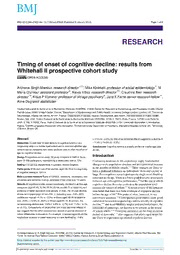Table Of ContentBMJ2012;344:d7622doi:10.1136/bmj.d7622(Published5January2012) Page1of8
Research
RESEARCH
Timing of onset of cognitive decline: results from
Whitehall II prospective cohort study
OPENACCESS
Archana Singh-Manoux research director123, Mika Kivimaki professor of social epidemiology2, M
Maria Glymour assistant professor4, Alexis Elbaz research director56, Claudine Berr research
director78,KlausPEbmeierprofessorofoldagepsychiatry9,JaneEFerrieseniorresearchfellow10,
Aline Dugravot statistician1
1InstitutNationaldelaSantéetdelaRechercheMédicale(INSERM),U1018,CentreforResearchinEpidemiologyandPopulationHealth,Hôpital
PaulBrousse,94807VillejuifCedex,France;2DepartmentofEpidemiologyandPublicHealth,UniversityCollegeLondon,London,UK;3Centrede
Gérontologie,HôpitalStePérine,AP-HP,France;4DepartmentofSociety,HumanDevelopment,andHealth,HarvardSchoolofPublicHealth,
Boston,MA,USA;5InstitutNationaldelaSantéetdelaRechercheMédicale(INSERM),U708,F-75013,Paris,France;6UPMCUnivParis06,
UMR_S708,F-75005,Paris;7InstitutNationaldelaSantéetdelaRechercheMédicale(INSERM)U1061UniversitéMontpellier1,Montpellier,
France;8CMRRLanguedoc-Roussillon,CHUMontpellier;9OxfordUniversityDepartmentofPsychiatry,WarnefordHospital,Oxford,UK;10University
ofBristol,Bristol,UK
Abstract (−4.5%to−2.8%)butthecrosssectionaleffectssuggestedadeclineof
ObjectivesToestimate10yeardeclineincognitivefunctionfrom −11.4%(−14.0%to−8.9%).
longitudinaldatainamiddleagedcohortandtoexaminewhetherage ConclusionsCognitivedeclineisalreadyevidentinmiddleage(age
cohortscanbecomparedwithcrosssectionaldatatoinfertheeffectof 45-49).
ageoncognitivedecline.
Introduction
DesignProspectivecohortstudy.Atstudyinceptionin1985-8,there
were10308participants,representingarecruitmentrateof73%. Continuingincreasesinlifeexpectancyimplyfundamental
SettingCivilservicedepartmentsinLondon,UnitedKingdom. changestothepopulationstructureandanexponentialincrease
inthenumberofelderlypeople.12Thesechangesarelikelyto
Participants5198menand2192women,aged45-70atthebeginning
haveaprofoundinfluenceonindividuals’livesandsocietyat
ofcognitivetestingin1997-9.
large.Poorcognitivestatusisperhapsthesinglemostdisabling
MainoutcomemeasureTestsofmemory,reasoning,vocabulary,and conditioninoldage.Thereisafinelygradedinverseassociation
phonemicandsemanticfluency,assessedthreetimesover10years. betweenageandcognitiveperformance,3-5buttheageatwhich
ResultsAllcognitivescores,exceptvocabulary,declinedinallfiveage cognitivedeclinebecomesevidentatthepopulationlevel
categories(age45-49,50-54,55-59,60-64,and65-70atbaseline),with remainsthesubjectofdebate.5-7Arecentreviewoftheliterature
evidenceoffasterdeclineinolderpeople.Inmen,the10yeardecline, concludedthattherewaslittleevidenceofcognitivedecline
shownaschange/rangeoftest×100,inreasoningwas−3.6%(95% beforetheageof60.8Thispointofview,however,isnot
confidenceinterval−4.1%to−3.0%)inthoseaged45-49atbaseline universallyaccepted.56Clinicopathologicalstudiesshowgood
and−9.6%(−10.6%to−8.6%)inthoseaged65-70.Inwomen,the correlationbetweenneuropathologyandtheseverityofcognitive
correspondingdeclinewas−3.6%(−4.6%to−2.7%)and−7.4%(−9.1% decline,9-11andneurofibrillarytanglesandamyloidplaques,the
to−5.7%).Comparisonsoflongitudinalandcrosssectionaleffectsof hallmarksofpathology,areknowntobepresentinthebrains
agesuggestthatthelatteroverestimatedeclineinwomenbecauseof ofyoungadults.1213Emergingconsensusonthelonggestation
cohortdifferencesineducation.Forexample,inwomenaged45-49the periodofdementia1415alsosuggeststhatadultsagedunder60
longitudinalanalysisshowedreasoningtohavedeclinedby−3.6% arelikelytoexperienceagerelatedcognitivedecline.
Correspondence to: A Singh-Manoux, INSERM, U1018, Centre for Research in Epidemiology and Population Health, Hôpital Paul Brousse, Bât
15/16, 16 Avenue Paul Vaillant Couturier, 94807 Villejuif Cedex, France [email protected]
Extra material supplied by the author (see http://www.bmj.com/content/344/bmj.d7622?tab=related#webextra)
Supplementary tables
No commercial reuse: See rights and reprints http://www.bmj.com/permissions Subscribe:http://www.bmj.com/subscribe
BMJ2012;344:d7622doi:10.1136/bmj.d7622(Published5January2012) Page2of8
RESEARCH
Theassessmentoftheeffectofageoncognitivedeclineisnot Weusedtwomeasuresofverbalfluency:phonemicand
straightforwardaslongitudinaldatathatspanmanydecadesare semantic.19Participantswereaskedtorecallinwritingasmany
rare.Crosssectionaldatamightnotaccuratelydistinguish wordsbeginningwith“S”(phonemicfluency)andasmany
longitudinalchange—thatis,theeffectofchronological animalnames(semanticfluency)astheycould.Oneminute
age—fromsecularchange,alsocalled“cohort”effects.Theage wasallowedforeachtest;theobservedrangeonthesetestswas
atwhichcognitivedeclinebeginsisimportantbecause 0-35.VocabularywasassessedwiththeMillHillvocabulary
behaviouralorpharmacologicalinterventionsdesignedtoalter test,20usedinitsmultiplechoiceformat,consistingofalistof
cognitiveageingtrajectoriesaremorelikelytoworkiftheyare 33stimuluswordsorderedbyincreasingdifficultyandsix
appliedwhenindividualsfirstbegintoexperiencedecline.We responsechoices.
examinedwhethercognitivedeclinebeginsbeforetheageof
60usingalargesampleofmiddleagedadultsfromthe Education
longitudinalWhitehallIIcohortstudy.Wealsoevaluatedthe
Educationwasassessedwithathreelevelvariable:didnot
biasinestimatesofcognitivedeclinedrawnfromcrosssectional
completesecondaryschool,obtainedhigherqualificationat
data.
secondaryschool(ataboutage18),andobtaineduniversity
degreeorhigher.Resultswithcontinuousyearsofeducation
Methods
weresimilarandarenotpresented.
Study population
Statistical analysis
TheWhitehallIIcohortwasestablishedin1985among10308
(67%men)Britishcivilservants.16Allcivilservantsaged35-55 Wefirstexaminedthecrosssectionalassociationsbetweenage
in20Londonbaseddepartmentswereinvitedtoparticipateby (infivecategories)andthecognitivetestsatbaselineusing
letter,and73%agreed.Althoughallparticipantsinthestudy linearregression.Alineartestfortrendwasusedtoassess
arewhitecollarworkers,awiderangeofoccupationsis whethercognitivescoreswereprogressivelylowerinolderage
representedwithasalarydifferenceofover10-foldbetween cohorts.Theagecohort×sexinteractions(alltestsP<0.001)led
thetopandbottomofthehierarchy.Studyinception(phase1) ustostratifytheseanalysesbysex.
wasovertheyears1985-8andinvolvedaclinicalexamination Linearmixedmodels21wereusedtoestimatecognitivedecline
andaselfadministeredquestionnaire.Subsequentphasesof overfollow-up.Thismethodusesallavailabledataover
datacollectionhavealternatedbetweeninclusionofa follow-up,takesintoaccountthefactthatrepeatedmeasures
questionnairealoneandaquestionnaireaccompaniedbya onthesameindividualarecorrelatedwitheachother,andcan
clinicalexamination.Thefocusoftheclinicalexaminationis handlemissingdata.Intheseanalysesboththeinterceptand
anthropometry,cardiovascularandmetabolicriskfactors,and theslopewerefittedasrandomeffects,allowingindividualsto
disease.Cognitivetestingwasintroducedtothefullcohort havedifferentcognitivescoresatbaselineanddifferentrates
duringtheclinicalexaminationatphase5(1997-9)andrepeated ofcognitivedeclineoverthefollow-up.Astheage
atphases7(2002-4)and9(2007-9),alongsidethestandard cohort×time×sexinteractions(reasoningP=0.59;memory
WhitehallIIclinicalscreeningmeasures. P=0.12;phonemicfluencyP=0.005;semanticfluencyP=0.02;
andvocabularyP=0.006)suggestedsexdifferencesincognitive
Age declineforsometests,wealsostratifiedtheseanalysesbysex.
Themodelsincludedtermsfortime(ageinyears,dividedby
Atbaselineforthisstudy(phase5ofWhitehallII)participants
10sothecoefficientsyieldeffectsofdeclineover10years),
wereaged45-70.Toallowcomparisonofcognitivedeclineas
agecohorts(ageatbaselineinfiveyearbands)toadjustfor
afunctionofagewecategorisedthisinfiveyearagegroups:
seculareffects,andaninteractiontermbetweenagecohortand
45-49,50-54,55-59,60-64,and65-70.
time,separatelyinmenandwomen.Thislastinteractionterm
allowsthecalculationoftheestimateof10yeardeclineinthe
Cognitive function
fiveagecohorts,undertakenwiththeoriginalscaleforalltests.
Thecognitivetestbattery,administeredatthreeclinical Astherangeofthefivecognitivetestsisdifferent,adeclineof
examinationsover10years(phases5,7,and9),waschosento onepointontheoriginalscalesofthetestsisnotcomparable.
provideacomprehensiveassessmentofcognitivefunctionand Toallowcomparisonacrosscognitivetests,wealsoexpress
beappropriateforthispopulationcomposedofindividuals cognitivedeclineintermsofpercentagechangeasafunction
youngerthaninmoststudiesoncognitiveageing.The oftherangeofeachtest(estimateof10yeardecline/rangeof
mini-mentalstateexamination,17althoughincludedinthetest test×100).Toassesswhetherthedeclinewasgreateratolder
battery,wasnotusedinthecurrentanalysisbecauseofceiling ageswiththetestforlineartrend,wererantheanalysisusing
effects(thatis,simpletestsleadingtolittlevariabilityinscores). thecategoriesofageasacontinuousvariable.
Thetestsincludedintheanalysis,describedbelow,hadgood
Wethenexaminedthecrosssectionalversuslongitudinaleffects
test-retestreliability(range0.60-0.89)in556participantswho
ofage;weshowresultsonlyfortheyoungestagecohortbut
wereinvitedbacktotheclinicwithinthreemonthsofhaving
theyweresimilarforallagecohorts(resultsavailablefromthe
takenthetestatbaseline.
firstauthoronrequest).Thelongitudinalestimatewasdrawn
TheAliceHeim4-I(AH4-I)iscomposedofaseriesof65verbal frommixedmodelswiththreecognitiveassessmentsover10
andmathematicalreasoningitemsofincreasingdifficulty.18It yearsinindividualsaged45-49atbaseline.Thecrosssectional
testsinductivereasoning,measuringtheabilitytoidentify estimateof“ageing”wassimplythedifferenceincognitive
patternsandinferprinciplesandrules.Participantshad10 scoresatbaselinebetweenthoseaged45-49and55-59at
minutestodothissection.Shorttermverbalmemorywas baseline.Theseanalyseswerethenadjustedforeducationto
assessedwitha20wordfreerecalltest.Participantswere examineitsimpactonthelongitudinalandcrosssectional
presentedalistof20oneortwosyllablewordsattwosecond estimatesof“ageing.”
intervalsandwerethenaskedtorecallinwritingasmanyof
Allcognitivedeclineresultsareexpressedaspercentchange
thewordsinanyorderwithintwominutes.
(change/rangeoftest×100)toallowcomparisonbetweenthe
No commercial reuse: See rights and reprints http://www.bmj.com/permissions Subscribe:http://www.bmj.com/subscribe
BMJ2012;344:d7622doi:10.1136/bmj.d7622(Published5January2012) Page3of8
RESEARCH
tests.Supplementarytablesonbmj.comshowresultswiththe aged55-59atbaselinethecorrespondingfigureswere38%,
originalscalesforthetests.Alltheanalyseswerecarriedout 33%,and29%formenand58%,25%,and17%forwomen.
withProcMixedprocedurefromtheSASsoftwareversion9.1
(SASInstitute,Cary,NC,USA). Discussion
Results Thisstudyofalargecohortofindividualsaged45-70at
baseline,usingthreecognitiveassessmentsover10years,
Ofthe10308participantsatstudyinception(1985-8),306had presentstwokeyfindings.Firstly,averageperformanceinall
diedand752hadwithdrawnfromthestudybeforethestartof cognitivedomains,exceptvocabulary,declinedoverfollow-up
thecognitivedatacollectionin1997-9.Ouranalysiswasbased inallagegroups,eveninthoseaged45-49.Theresultsfor
on7390(5198menand2192women)ofthe9250individuals vocabularywereexpectedasitisknowntobelittleinfluenced
stillinthestudy.Thoseincludedintheanalysesweremore byage.4Secondly,comparisonsoftheeffectofagein
educated(29.5%v20.8%hadauniversitydegree,P<0.001) longitudinalandcrosssectionalanalysissuggestthatcross
andwereyounger(responserateswere84%(1526/1818)in sectionaldatacannotprovidereliableestimatesofagerelated
thoseaged45-49,82%(2160/2643)inthoseaged50-54,79% cognitivedeclinebecausetheyconflatetheeffectofagewith
(1580/1992)inthoseaged55-59,79%(1564/1976)inthose differencesinbirthcohortsinkeyfactorssuchaseducation.In
aged60-64,and68%(560/821)inthoseaged65-70).Ofthe ourstudy,crosssectionaldataconsiderablyoverestimated
7390individualsincludedintheanalysis,wehadcompletedata cognitivedeclineamongwomenbutnotinmen,aprobable
for4675(63%)atallthreephases,1613attwophases,and1102 consequenceofcohortdifferencesineducation.Thus,
atonlyonephase. differencesineducationalqualificationsorotherfactorsbetween
Duringthe10yearfollow-up,305/7390(4%)died.Mortality agecohortswouldbiasestimatesofcognitivedeclinedrawn
overthisperiodwashigherinthosewithpoorercognitivescores fromcrosssectionaldata.
atbaseline(P<0.01onalltests).Exclusionoftheseindividuals Therearepotentialcaveatstotheresultsreportedhere.
fromtheanalysisdidnotmodifytheresultsmuch,leadingus Longitudinaldataareknowntounderestimatetheeffectofage
toretainthemintheanalyses.Table1⇓presentscharacteristics becauseofpracticeeffects22andaresubjecttoselectivesample
oftheparticipantsincludedintheanalysisandtheirbaseline retention.23Inourstudynon-responsewashigherintheolder
cognitivescores(phase5,1997-9).Therewasacrosssectional individuals,affectingbothcrosssectionalaswelland
associationbetweenageatbaseline,categorisedintofiveage longitudinalestimates.Asnon-responsewasnotsubstantial(the
cohortsoffiveyearseachspanning45-70years,andall overallresponseratewas80%(7390/9250)inthoseinvitedto
cognitivescores(allP<0.001),exceptvocabularyinmen cognitivetesting),however,majorbiasisunlikely.Theobvious
(P=0.13)(seetableAonbmj.com). advantageofusinglongitudinalanalysisisthattheestimatesof
Thefigure⇓presentsestimatesofcognitivedecline,expressed cognitivedeclinearebasedonchangeswithinanindividual,
aspercentchange(change/rangeoftest×100)overthe10year andtheseareunlikelytobeaffectedbyerrorarisingfromnatural
follow-upperiodusingthreewavesofdata(resultsusingthe variationbetweenindividuals.Theexposure,inthiscasetime
originalscaleforthetestsareshowninsupplementarytableB over10years,isuniformlyapplicabletoallagecohortsinthe
onbmj.com).Therewassomeevidenceofgreaterdeclineat analysis.ItmustalsobenotedthatWhitehallIIisnot
olderagesandofalineartrendindeclinewithincreasingage representativeofthegeneralpopulation.Theparticipantsare
forsomeofthetests,particularlyinmen(fig1andtableBon mostlywhitecollarworkersinrelativelystableemployment
bmj.com).Forexample,inmenaged45-49atbaseline,10year andtwothirdsaremen,implyingthatourresultscould
declineinreasoningwas−3.6%(95%confidenceinterval−4.1% underestimatecognitivedeclineatthepopulationlevel.Thesex
to−3.0%)whileinthoseaged65-70itwas−9.6%(−10.6%to specificcohortdifferencesineducationalattainmentseenin
−8.6%).Inwomen,thecorrespondingdeclinewas−3.6% thissample,however,reflectglobaltrendsineducational
(−4.6%to−2.7%)inthoseaged45-49and−7.4%(−9.1%to opportunitiesacrossthe20thcentury.2425
−5.7%)inthoseaged65-70.Theresultsforalltests,except Theageatwhichcognitivedeclinebeginsissubjecttomuch
vocabulary,showedsignificantdeclinesinallagecategoriesin debate.5-26Arecentreviewofstudiesconcludedthatthereisno
bothmenandwomenastheconfidenceintervalsdidnotinclude cognitivedeclinebeforetheageof60.8Thisconclusionwas
zero. drawnmostlyfromresultsoftheSeattlelongitudinalstudy,in
Inthefinalsetofanalyseswecomparedthelongitudinaland which500individuals,withanagerangeatbaselinefromearly
crosssectionaleffectsofageon“cognitivedecline.”Theresults, 20stolate60s,havebeenfollowedsince1956withtheaddition
presentedintable2⇓aspercentchange(change/rangeof ofnewparticipantsatsuccessivewavesofdatacollection.27In
test×100)andintableConbmj.comusingtheoriginalscale, anotherstudy,149individualsaged30-81werefollowedfor
suggestthatinwomen,butnotmen,thecrosssectionalanalysis 16years,andresultsshowedlittlecognitivedeclinebeforethe
considerablyoverestimatedtheeffectofageing.Forexample, ageof55.28Onechallengeinsmallscalestudiessetupto
thelongitudinalanalysisinwomenshowsreasoningtohave investigate“cognitiveageing”isthattheymightbebasedona
declinedby−3.6%(−4.5%to−2.8%)inthoseaged45-49but selectedsampleofindividuals.Estimatesofcognitivedecline
thecrosssectionaleffectssuggestadeclineof−11.4%(−14.0% canalsobebiasedbecauseoftheexistenceofpracticeand
to−8.9%).Adjustmentforeducationdidnotchangethe learningeffects,2228knowntovaryasacomplexfunctionof
longitudinalestimatesmuchbutsubstantiallyreducedthecross age,levelofability,andcomplexityoftask.22Theratesof
sectionalestimatesoftheeffectofageingoncognitivedecline. declineincognitivetestscoresweestimatedmightunderstate
Therewereconsiderablecohortdifferencesineducationin theactualrateofdeclinebecausepracticeeffectscanoffsetage
women.Inmenaged45-49yearsatbaseline,30%hadlessthan relateddeclines.Ourfindingofdeclinesineventheyoungest
asecondaryschooleducation,28%hadcompletedsecondary agegroup(age45-49)isallthemorecompellingbecauseitis
schooleducation,and42%hadauniversitydegree.Forwomen presumablyalowerboundestimate.
thecorrespondingfigureswere34%,28%,and40%.Forthose Giventhecomplexityofassessingcognitivedecline,some
authorssupporttheuseofcrosssectionaldatatoestimatethe
No commercial reuse: See rights and reprints http://www.bmj.com/permissions Subscribe:http://www.bmj.com/subscribe
BMJ2012;344:d7622doi:10.1136/bmj.d7622(Published5January2012) Page4of8
RESEARCH
effectsofageingoncognitivefunction.5-30Theseestimates, thanthemeandeclineintheiragegroup,particularlyatyounger
however,reflectboththeeffectsofchronologicalageingand ages,mightmeritfurtherattention.Determiningtheagewindow
cohorteffects,eachproducedbydistinctunderlying atwhichpotentialinterventionsarelikelytobemostbeneficial
mechanisms.Ageeffectsarecausedbychangesthatpeoplego isalsoacrucialnextstep.
throughastheygetolderandreflectbiologicalageing.Cohort
effectsareproducedwhenabirthcohortentersadultlifewith Wethankalltheparticipatingcivilservicedepartmentsandtheirwelfare,
longlastingeffectsoncognitivefunctionbecauseofchildhood personnel,andestablishmentofficers;theBritishOccupationalHealth
experienceslikequalityofeducation,nutrition,socioeconomic andSafetyAgency;theBritishCouncilofCivilServiceUnions;all
circumstances,etc.31-33Ourdatashowlargercohorteffectsin participatingcivilservantsintheWhitehallIIstudy;andallmembersof
womenbecauseofdifferencesineducationalattainmentacross theWhitehallIIstudyteam.TheWhitehallIIStudyteamcomprises
thebirthcohortsinourstudypopulation.Adjustmentfor researchscientists,statisticians,studycoordinators,nurses,data
educationdoesnotadequatelydealwiththisproblemfortwo managers,administrativeassistants,anddataentrystaff,whomake
reasons.Firstly,education,asmeasured,mightnotcaptureall thestudypossible.
effectsrelatedtocohortdifferences;secondly,itmight
Contributors:AS-Mwrotethefirstandsuccessivedraftsofthepaper.
overcorrecttheestimateforcognitivedeclinebyattributing
ADcarriedoutallthestatisticalanalysis.Allauthorscontributedtothe
sharedvariancebetweenageandeducationtothelatter
interpretationofresultsandrevisionofthepaperandapprovedthefinal
(education).
versionofthepaper.AS-Misguarantor.
Funding:ASMissupportedbyaEuropeanYoungInvestigatorAward
Implications and conclusions
fromtheEuropeanScienceFoundationandtheNationalInstituteon
Adversecognitiveoutcomeslikedementiaarenowthoughtto Aging,NIH(R01AG013196[PI];R01AG034454[PI]).MKissupported
betheresultoflongtermprocessesoveratleast20-30years,1415 bytheBUPAFoundation,theNationalInstitutesofHealth
leadingsomeauthorstoarguefortheimportanceofapproaches (R01HL036310[PI];R01AG034454[PI])andtheAcademyofFinland.
duringlife.1534Despitemuchresearchonearlydiagnosis, TheWhitehallIIstudyisalsosupportedbyagrantfromtheBritish
pathophysiologicalandclinicalstudieshaveyettoidentify MedicalResearchCouncil(G0902037)andtheBritishHeartFoundation.
biomarkersorcognitiveprofilesthataccuratelypredict Thefundingbodieshadnoroleinthestudydesign,thecollection,
dementia.3-36Nevertheless,thereisenoughevidencetoshow analysisandinterpretationofdata,thewriting,andthedecisiontosubmit
theimportanceofhealthylifestylesandcardiovascularrisk thepaper.
factorsinadulthoodfordementia.3536Forsomeoftheserisk Competinginterests:AllauthorshavecompletedtheICMJEuniform
factors,suchasobesity,hypertension,and disclosureformatwww.icmje.org/coi_disclosure.pdf(availableon
hypercholesterolaemia,itismid-lifelevelsthatseemtobemore requestfromthecorrespondingauthor)anddeclare:nosupportfrom
importantthanthosemeasuredatolderages.35Thereisemerging anyorganisationforthesubmittedwork;nofinancialrelationshipswith
consensusthat“whatisgoodforourheartsisalsogoodforour anyorganisationsthatmighthaveaninterestinthesubmittedworkin
heads,”3637makingaggressivecontrolofbehaviouraland thepreviousthreeyears;nootherrelationshipsoractivitiesthatcould
cardiovascularriskfactorsasearlyaspossiblekeytargetsfor appeartohaveinfluencedthesubmittedwork.
clinicalpracticeandpublichealth.
Ethicalapproval:ThisstudywasapprovedbytheUniversityCollege
Ourresultshaveprofoundimplicationsforthedesignofresearch Londonethicscommittee,andallparticipantsprovidedwrittenconsent.
usedinstudiesofageing.Muchresearchinthisdomain,
Datasharing:WhitehallIIdata,protocols,andothermetadataare
includingthatondementia,assessesbothputativeriskfactors
availabletothescientificcommunity.PleaserefertotheWhitehallII
andtrajectoriesofcognitivedeclineinelderlypeople.While
datasharingpolicyatwww.ucl.ac.uk/whitehallII/data-sharing.
thisallowsasufficientnumberofpeoplewithdementiatobe
identifiedwithfollow-upsoflessthan10years,theimplicit 1 OeppenJ,VaupelJW.Demography.Brokenlimitstolifeexpectancy.Science
assumptionmadeinthesestudiesisthatthereislittlecognitive 2002;296:1029-31.
2 LutzW,SandersonW,ScherbovS.Thecomingaccelerationofglobalpopulationageing.
declineuntiloldageorthatthedecline,includingtherateof
Nature2008;451:716-9.
decline,inthoseagedlessthan60isnotclinicallyimportant. 3 BrayneC.Theelephantintheroom—healthybrainsinlaterlife,epidemiologyandpublic
Onelikelyconsequenceofstudiesonolderpeopleisthatsome health.NatRevNeurosci2007;8:233-9.
4 HollandCA,RabbittPMA.Thecourseandcausesofcognitivechangewithadvancing
oftheriskfactorsuncoveredcouldsimplybecorrelatesofthe age.RevClinGerontol1991;1:81-96.
diseaseprocessratherthancausesoftheoutcomeunder 5 SalthouseTA.Whendoesage-relatedcognitivedeclinebegin?NeurobiolAging
2009;30:507-14.
investigation. 6 FinchCE.Theneurobiologyofmiddle-agehasarrived.NeurobiolAging2009;30:515-20.
Lifeexpectancycontinuestoincrease,1andunderstanding 7 NilssonLG,SternangO,RonnlundM,NybergL.Challengingthenotionofanearly-onset
ofcognitivedecline.NeurobiolAging2009;30:521-4.
cognitiveageingwillbeoneofthechallengesofthiscentury. 8 HeddenT,GabrieliJD.Insightsintotheageingmind:aviewfromcognitiveneuroscience.
Weexplicitlyexaminedtheimpactofageoncognitivedecline NatRevNeurosci2004;5:87-96.
9 NelsonPT,BraakH,MarkesberyWR.Neuropathologyandcognitiveimpairmentin
becausebetterunderstandingofbothadverseandhealthy Alzheimerdisease:acomplexbutcoherentrelationship.JNeuropatholExpNeurol
cognitiveageingtrajectoriesmighthelptheidentificationof 2009;68:1-14.
10 WilsonRS,LeurgansSE,BoylePA,SchneiderJA,BennettDA.Neurodegenerativebasis
earlyriskfactorsforadversecognitiveoutcomes.Thereare ofage-relatedcognitivedecline.Neurology2010;75:1070-8.
otherchangesoccurring:thedraftfiftheditionoftheDiagnostic 11 JohnsonDK,StorandtM,MorrisJC,GalvinJE.Longitudinalstudyofthetransitionfrom
healthyagingtoAlzheimerdisease.ArchNeurol2009;66:1254-9.
andStatisticalManualofMentaldisorders(www.dsm5.org)
12 BraakH,BraakE.FrequencyofstagesofAlzheimer-relatedlesionsindifferentage
suggestsreplacingdementiawith“major”and“minor categories.NeurobiolAging1997;18:351-7.
13 DuyckaertsC,HauwJJ.Prevalence,incidenceanddurationofBraak’sstagesinthe
neurocognitivedisorder,”achangethatislikelytofocus
generalpopulation:canweknow?NeurobiolAging1997;18:362-9.
attentiononbetterunderstandingoftheeffectofageon 14 Alzheimer’sDiseaseInternational.WorldAlzheimerreport.Alzheimer’sDisease
cognition. International,2009.
15 LaunerLJ.Theepidemiologicstudyofdementia:alife-longquest?NeurobiolAging
Futureresearchneedstoidentifythedeterminantsofcognitive 2005;26:335-40.
16 MarmotM,BrunnerE.Cohortprofile:theWhitehallIIstudy.IntJEpidemiol2005;34:251-6.
declineandassesstheextenttowhichthecognitivetrajectories
17 FolsteinMF,FolsteinSE,McHughPR.“Mini-mentalstate.”Apracticalmethodforgrading
ofindividualsaremodifiable.Weexaminedmeandeclinein thecognitivestateofpatientsfortheclinician.JPsychiatrRes1975;12:189-98.
18 HeimAW.AH4grouptestofgeneralintelligence.NFER-Nelson,1970.
eachagegroupbutindividualswhoexperiencedeclinesgreater
19 BorkowskiJG,BentonAL,SpreenO.Wordfluencyandbraindamage.Neuropsychologica
1967;5:135-40.
No commercial reuse: See rights and reprints http://www.bmj.com/permissions Subscribe:http://www.bmj.com/subscribe
BMJ2012;344:d7622doi:10.1136/bmj.d7622(Published5January2012) Page5of8
RESEARCH
Whatisalreadyknownonthistopic
Cognitivefunctiondeclineswithage;impairedcognitivestatusisahallmarkofdementia
Theageatwhichcognitivedeclinebeginsremainsunknown,thougharecentreviewoftheliteraturesuggeststhereislittleevidenceof
declinebeforetheageof60
Whatthisstudyadds
Longitudinalmodellingofcognitivedeclineusingthreemeasuresover10yearsprovidesrobustevidenceofcognitivedeclineatallages
between45and70,evenamongthoseaged45-49atbaseline
The10yeardeclineinreasoningwas−3.5%inmenaged45-49atbaselineand−9.6%amongthoseaged65-70;thecorresponding
figuresforwomenwere−3.6%and−7.4%
Agerelateddeclineincognitivefunctioncannotbeassessedaccuratelywithcrosssectionaldata
20 RavenJC.GuidetousingtheMillHillvocabularytestwithprogressivematrices.HKLewis, 32 SchaieKW,Labouvie-ViefG.Generationalversusontogeneticcomponentsofchangein
1965. adultcognitivebehavior:afourteen-yearcross-sequentialstudy.DevPsychol
21 LairdNM,WareJH.Random-effectsmodelsforlongitudinaldata.Biometrics 1974;10:305-20.
1982;38:963-74. 33 DickensWT,FlynnJR.Heritabilityestimatesversuslargeenvironmentaleffects:theIQ
22 RabbittP,DiggleP,SmithD,HollandF,McInnesL.Identifyingandseparatingtheeffects paradoxresolved.PsycholRev2001;108:346-69.
ofpracticeandofcognitiveageingduringalargelongitudinalstudyofelderlycommunity 34 WhalleyLJ,DickFD,McNeillG.Alife-courseapproachtotheaetiologyoflate-onset
residents.Neuropsychologia2001;39:532-43. dementias.LancetNeurol2006;5:87-96.
23 EuserSM,SchramMT,HofmanA,WestendorpRG,BretelerMM.Measuringcognitive 35 BallardC,GauthierS,CorbettA,BrayneC,AarslandD,JonesE.Alzheimer’sdisease.
functionwithage:theinfluenceofselectionbyhealthandsurvival.Epidemiology Lancet2011;377:1019-31.
2008;19:440-7. 36 RichardsM,BrayneC.WhatdowemeanbyAlzheimer’sdisease?BMJ2010;341:c4670.
24 UnitedNationsEducationalSaCOU.Worldeducationreport2000.UNESCO,2000. 37 ViswanathanA,RoccaWA,TzourioC.Vascularriskfactorsanddementia:howtomove
25 GoldinC.America’sgraduationfromhighschool:theevolutionandspreadofsecondary forward?Neurology2009;72:368-74.
schoolinginthetwentiethcentury.JEconHist1998;58:345-74.
Accepted:26October2011
26 FinchCE.Middleage:anevolvingfrontieringerontology.NeurobiolAging1991;12:1-2.
27 SchaieKW.Thecourseofadultintellectualdevelopment.AmPsychol1994;49:304-13.
28 ZelinskiEM,BurnightKP.Sixteen-yearlongitudinalandtimelagchangesinmemoryand
Citethisas:BMJ2012;344:d7622
cognitioninolderadults.PsycholAging1997;12:503-13.
29 SalthouseTA.Influenceofageonpracticeeffectsinlongitudinalneurocognitivechange. Thisisanopen-accessarticledistributedunderthetermsoftheCreativeCommons
Neuropsychology2010;24:563-72.
AttributionNon-commercialLicense,whichpermitsuse,distribution,andreproductionin
30 SalthouseTA,SchroederDH,FerrerE.Estimatingretesteffectsinlongitudinal
assessmentsofcognitivefunctioninginadultsbetween18and60yearsofage.Dev anymedium,providedtheoriginalworkisproperlycited,theuseisnoncommercialand
Psychol2004;40:813-22. isotherwiseincompliancewiththelicense.See:http://creativecommons.org/licenses/by-
31 RyderNB.Thecohortasaconceptinthestudyofsocialchange.AmSociolRev nc/2.0/andhttp://creativecommons.org/licenses/by-nc/2.0/legalcode.
1965;30:843-61.
No commercial reuse: See rights and reprints http://www.bmj.com/permissions Subscribe:http://www.bmj.com/subscribe
BMJ2012;344:d7622doi:10.1136/bmj.d7622(Published5January2012) Page6of8
RESEARCH
Tables
Table1|CharacteristicsofstudypopulationinWhitehallII.Figuresarenumbers(percentage)unlessstatedotherwise
Men(n=5198) Women(n=2192) Pvalue*
Mean(SD)ageatbaseline(years) 55.5(5.9) 56.2(6.0) <0.001
White 4859(93.5) 1888(86.1) <0.001
Married/cohabiting 4319(83.1) 1327(60.5) <0.001
Education†:
Lessthansecondaryschool 1964(39.4) 1163(56.6) <0.001
Secondaryschool 1370(27.5) 467(22.7)
University 1649(33.1) 424(20.6)
Mean(SD)cognitivefunctionatbaseline‡:
Reasoning(range0-65) 48.7(10.0) 41.6(12.2) <0.001
Memory(range0-20) 6.9(2.3) 6.9(2.7) 0.39
Phonemicfluency(range0-35) 16.9(4.2) 16.5(4.7) <0.001
Semanticfluency(range0-35) 16.7(4.0) 15.8(4.6) <0.001
Vocabulary(range0-33) 25.7(3.8) 23.1(5.5) <0.001
*Fordifferencebetweenmenandwomen.
†Datamissingfor215menand138women.
‡In4170menand1679women(5849of7390participantsincludedinlongitudinalanalysis)whohadcompletedataonfivecognitivetestsatbaseline.
No commercial reuse: See rights and reprints http://www.bmj.com/permissions Subscribe:http://www.bmj.com/subscribe
BMJ2012;344:d7622doi:10.1136/bmj.d7622(Published5January2012) Page7of8
RESEARCH
Table2|Comparisonofcognitivedecline(expressedas%change*)fromlongitudinalandcrosssectionaleffectsinsubsample†of
participantsinWhitehallstudy
Longitudinalanalysis(participantsaged45-49atbaseline Crosssectionalanalysis(differenceinscorebetween
followedupfor10years) thoseaged45-49and55-59atbaseline)
10yeardecline(95%CI) 10yeardecline(95%CI)
10yeardecline(95%CI) adjustedforeducation‡ Difference(95%CI) adjustedforeducation‡
Men
Reasoning(AH4-I) −3.6(−4.1to−3.1) −3.6(−4.1to−3.1) −3.2(−4.5to−1.8) −1.9(−3.2to−0.6)
Memory −2.9(−3.6to−2.2) −2.9(−3.6to−2.2) −3.6(−4.6to−2.5) −3.1(−4.1to−2.0)
Phonemicfluency −3.9(−4.5to−3.3) −3.9(−4.5to−3.4) −2.9(−4.1to−1.8) −2.3(−3.4to−1.2)
Semanticfluency −3.4(−4.0to−2.8) −3.5(−4.1to−2.9) −3.4(−4.4to−2.3) −2.8(−3.8to−1.7)
Vocabulary 0.7(0.4to1.1) 0.7(0.37to1.1) 1.0(−0.1to2.1) 2.1(1.1to3.1)
Women
Reasoning(AH4-I) −3.6(−4.5to−2.8) −3.6(−4.5to−2.8) −11.4(−14.0to−8.9) −7.2(−9.6to−4.8)
Memory −2.6(−4.0to−1.3) −2.5(−3.8to−1.1) −6.5(−8.3to−4.6) −5.0(−6.9to−3.1)
Phonemicfluency −4.2(−5.2to−3.2) −4.3(−5.3to−3.3) −6.5(−8.4to−4.6) −4.4(−6.3to−2.5)
Semanticfluency −3.1(−4.1to−2.0) −2.9(−3.9to−1.9) −7.9(−9.8to−6.0) −5.2(−7.0to−3.3)
Vocabulary 0.8(0.2to1.4) 0.8(0.18to1.5) −7.4(−9.7to−5.1) −3.5(−5.6to−1.3)
*Change/rangeoftest×100.
†Longitudinalanalysis:1076menand396women;crosssectionalanalysis:918menand329womenaged45-49and836menand364womenaged55-59.
‡Inthoseaged45-49atbaseline30%ofmenand34%ofwomenhadlessthansecondaryschooleducation,28%and26%hadsecondaryschooleducation,and
42%and40%hadauniversitydegree.Forthoseaged55-59atbaselinecorrespondingfigureswere38%and58%,33%and25%,and29%and17%.
No commercial reuse: See rights and reprints http://www.bmj.com/permissions Subscribe:http://www.bmj.com/subscribe
BMJ2012;344:d7622doi:10.1136/bmj.d7622(Published5January2012) Page8of8
RESEARCH
Figure
Declineincognitivetestscoresover10years(%change=change/rangeoftext×100)asfunctionofbaselineagecohortin
menandwomen,estimatedfromlinearmixedmodels.Pvaluesdenotetestforlineartrendacrossagecategories,derived
byenteringthemascontinuousvariable
No commercial reuse: See rights and reprints http://www.bmj.com/permissions Subscribe:http://www.bmj.com/subscribe

